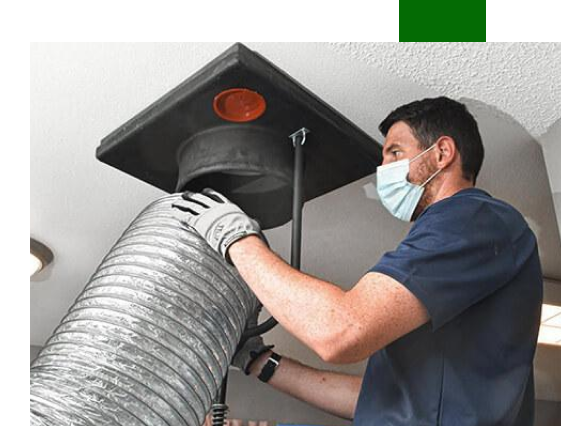Boosting Comfort and Cutting Costs: The Hidden Secret to HVAC Energy Efficiency
When it comes to making homes more energy-efficient, most people think of solar panels, smart thermostats, or new insulation. While these upgrades are beneficial, there’s a surprisingly simple strategy that often gets missed: keeping your air ducts clean. Neglecting this one aspect can sabotage your HVAC system’s performance and cost you more than you realize.
Air Duct Cleaning doesn’t just improve air quality—it plays a critical role in maximizing HVAC energy efficiency. In this guide, we’ll explore how duct maintenance improves energy use, comfort, and long-term savings.
How Dirty Ducts Sabotage HVAC Energy Efficiency
Unwanted Blockages = Unnecessary Energy Waste
Dust, pet dander, mold, and other pollutants gradually clog your air ducts. This disrupts airflow, forcing your HVAC system to work harder, longer, and less efficiently. It’s like trying to breathe through a straw.
The Ripple Effect on System Components
A blocked airflow doesn’t just raise energy bills. It also puts pressure on your HVAC components—motors, fans, compressors—which shortens their lifespan and increases the risk of breakdowns.
Less Flow, Less Comfort
Restricted airflow means uneven temperature distribution. One room may feel like a sauna while another is freezing. Clean ducts allow your HVAC system to work the way it was designed—delivering consistent comfort.
The Payoff of Clean Ducts: Real Gains in HVAC Energy Efficiency
Cleaning your ducts regularly has a direct impact on HVAC energy efficiency. Here’s how:
- Better Air Circulation: Clean ducts eliminate resistance, helping air move freely through your system.
- Faster Temperature Regulation: With fewer obstructions, your HVAC system reaches target temperatures more quickly.
- Lower Energy Bills: Efficiency means less power used per cycle, translating to monthly savings.
- Longer HVAC Lifespan: Reduced strain equals longer life for motors and compressors.
- Improved Indoor Air Quality: Removing dust, bacteria, and allergens creates a healthier environment.
These benefits compound over time—boosting performance while minimizing maintenance costs.
Why You Shouldn’t Wait: Signs Your Ducts Need Attention
Be on the lookout for these warning signs:
- Sudden spike in utility bills
- Uneven room temperatures
- Dust buildup around vents
- Allergy flare-ups indoors
- No recent duct cleaning in over 3 years
If any of these sound familiar, it’s time to prioritize your system’s health—and your HVAC energy efficiency.
The Duct Cleaning Process: What to Expect
Thinking about calling the pros? Here’s a look at the typical process:
Initial Inspection
Technicians assess the state of your ducts with cameras or specialized tools.
System Setup
They seal and prepare your HVAC system to prevent mess or damage.
Deep Cleaning
Using industrial vacuums and brushes, they extract years’ worth of buildup from the ductwork.
Final Test
Airflow is measured, and filters may be replaced for optimal performance.
Additional Tips to Maximize HVAC Energy Efficiency
Cleaning your ducts is a great start, but don’t stop there. Boost your home’s performance with these bonus tips:
- Upgrade to HEPA filters
- Seal duct leaks with professional-grade tape
- Schedule annual HVAC tune-ups
- Keep vents unobstructed by furniture or rugs
- Install a programmable or smart thermostat
These habits work in tandem with clean ducts to take your HVAC Energy Efficiency to the next level.
Description List: Common HVAC Terms Explained
Here’s a quick glossary to help you understand the lingo:
Air Handler The component that moves air throughout your home via fans and blowers.
SEER Rating Seasonal Energy Efficiency Ratio—a measure of cooling efficiency.
MERV Rating Minimum Efficiency Reporting Value—rates filter effectiveness.
Plenum The box-like compartment that distributes or collects air from ducts.
Return Ducts Ducts that carry air from rooms back into the HVAC system.
Frequently Asked Questions (FAQ)
Q1: How often should I clean my air ducts to maintain HVAC energy efficiency? A: Every 3 to 5 years is standard, but homes with pets, smokers, or allergies may need more frequent cleanings.
Q2: Can I clean my own ducts to improve HVAC energy efficiency? A: Surface cleaning is possible, but professional tools are required to remove deep-seated debris and contaminants effectively.
Q3: Does duct cleaning really lower energy bills? A: Yes. By reducing airflow resistance and system workload, duct cleaning can significantly improve HVAC energy efficiency and reduce power use.
Q4: Is HVAC energy efficiency only about saving money? A: No—it also improves indoor comfort, reduces carbon footprints, and extends system lifespan.
Q5: Will duct cleaning eliminate odors? A: It can help, especially if the odors are due to mold, dust, or pests in the ductwork.
Small Action, Big Results
Investing in duct cleaning may not sound as glamorous as installing a high-end thermostat, but its impact is undeniable. For homeowners aiming to maximize comfort, minimize costs, and enhance indoor health, this is the low-hanging fruit of energy upgrades.
Don’t wait for your system to falter. Make clean ducts a part of your home care routine and let your HVAC energy efficiency soar—just like smart digital marketing drives engagement, clean ducts drive consistent performance in your home.
